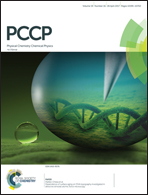Light-induced confinement of electrons in stacked distorted graphene layers – a (TD-)DFT study†
Abstract
Recently observed white-light emission from graphene ceramics cannot be explained by black body radiation theory because of a relatively low temperature of the sample. Furthermore the intensity of the emission stays at the same level even at temperatures as low as 10 K, indicating the purely electronic nature of the observed emission. In this work a model of light emission from locally interacting stacked graphene layers after intense continuous wave laser excitation is proposed. After a light-induced sp2 to sp3 change of the hybridization sp2-nanodomains surrounded by sp3 carbon atoms could be created and the electrons can be confined. Using DFT and TD-DFT methods followed by a molecular-like approach we examine the electronic structure and the optical properties of graphene (sp2,sp3)-clusters. We show the quantized and well separated energy levels of electrons from the domain's interior and the possibility of emission in the NIR/VIS/UV range.



 Please wait while we load your content...
Please wait while we load your content...